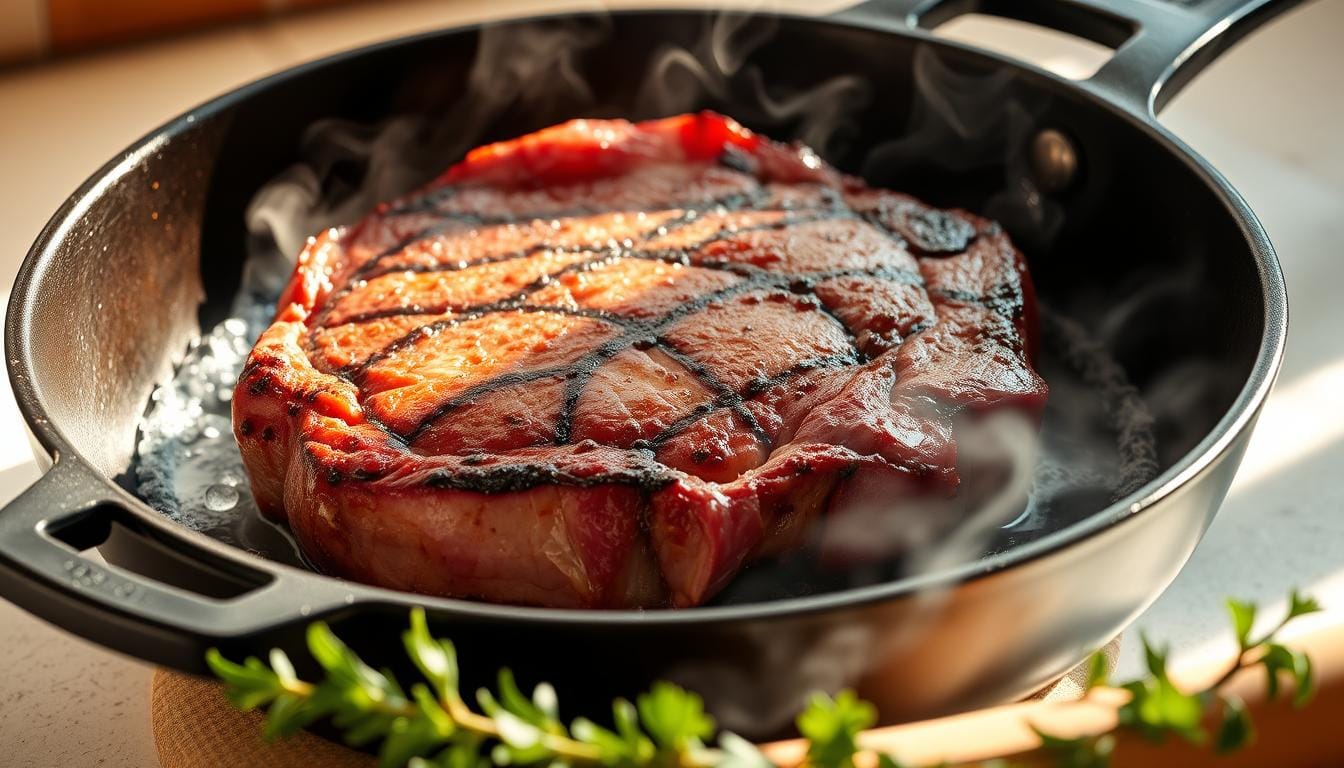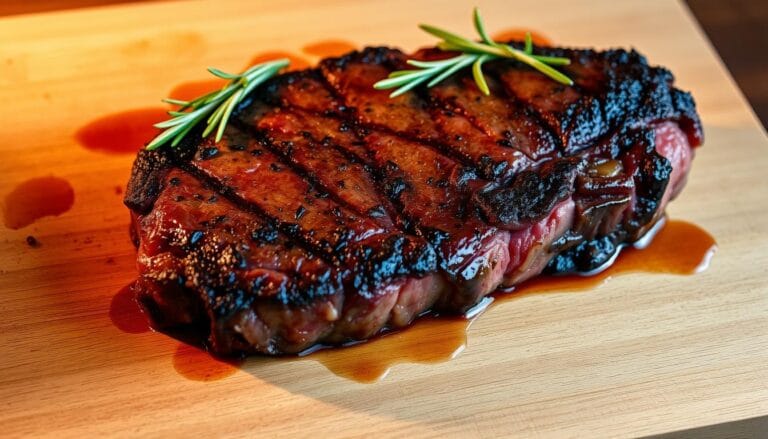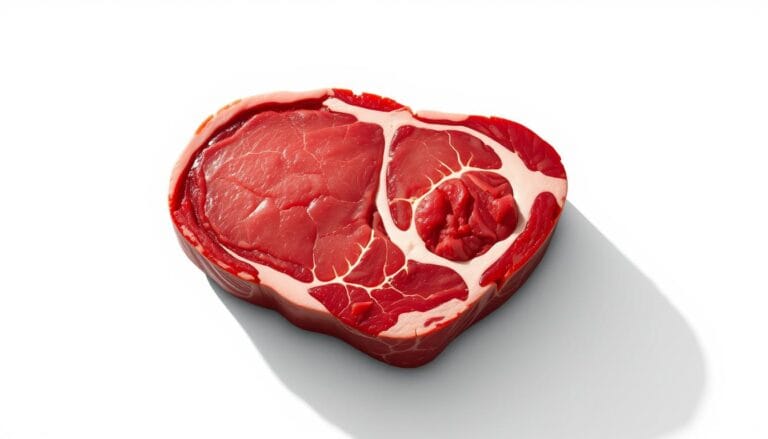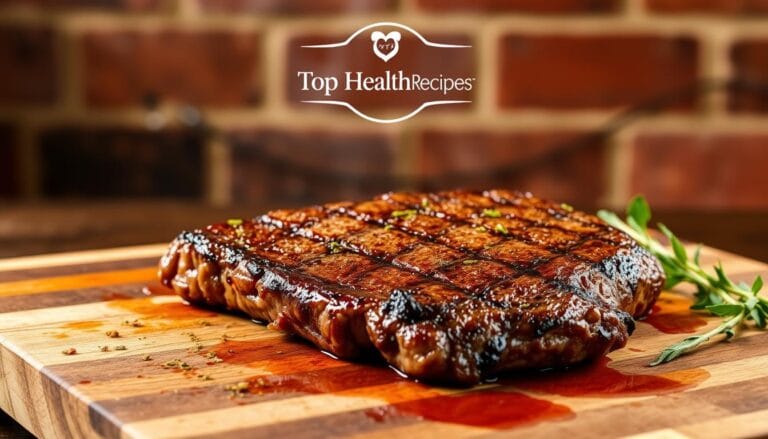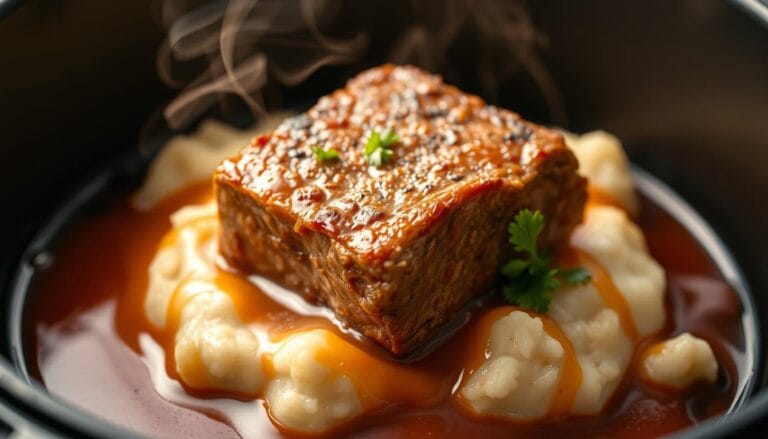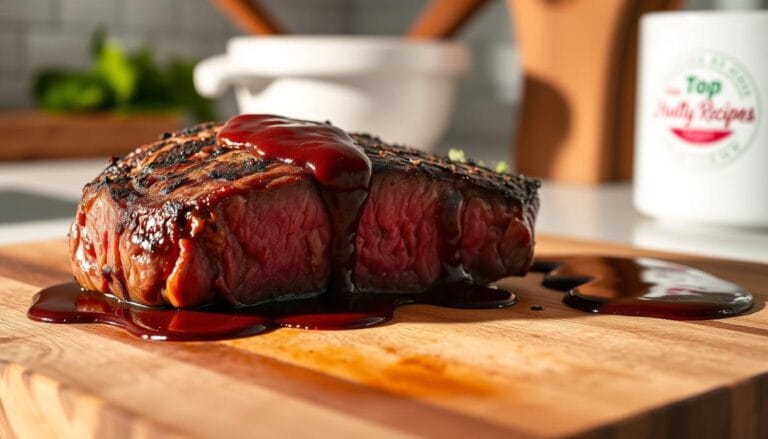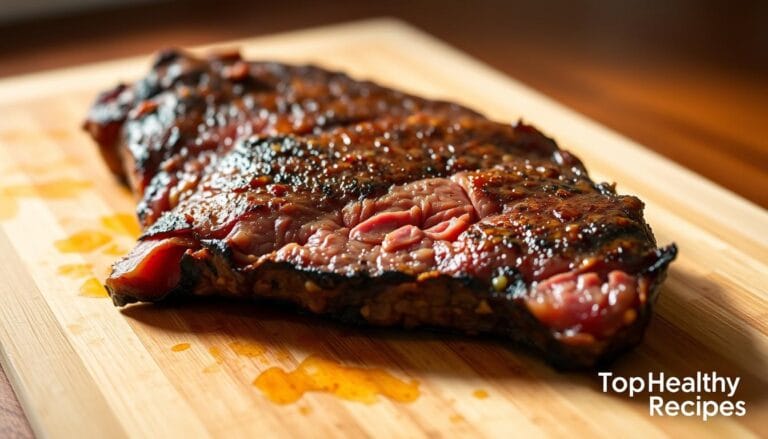Best Recipe for Delmonico Steak – Juicy, Flavorful, and Easy to Make
Table of Contents
Best Recipe for Delmonico Steak – Juicy, Flavorful, and Easy to Make
Imagine enjoying a tender, juicy piece of beef that’s full of rich flavor. A well-cooked Delmonico cut is a true culinary joy. It’s known for its tender texture and deep flavor, making it a favorite among steak lovers for years.
You don’t need to be a pro chef to make a delicious Delmonico at home. With some guidance, you can cook a mouth-watering Delmonico steak. We’ll show you how to pick the best cut and cook it to perfection.
Key Takeaways
- Learn how to select the perfect Delmonico cut for maximum flavor and tenderness.
- Discover simple preparation methods to enhance the natural flavors.
- Master cooking techniques to achieve a perfectly cooked Delmonico steak every time.
- Understand the importance of resting and serving techniques.
- Get tips on pairing your Delmonico steak with the perfect sides and wines.
What is Delmonico Steak?
Do you know where Delmonico steak comes from? It’s a dish with a rich history, enjoyed for centuries. Its story starts at Delmonico’s Restaurant in New York City.
History and Origins
Delmonico’s Restaurant opened in 1830 and was a leader in fine dining. It was here that the Delmonico steak was first introduced. It quickly became a favorite among the city’s elite.
“Delmonico’s was a place where the aristocracy of America’s culinary world came to dine, and the Delmonico steak was one of its crown jewels.”
Different Cuts Included
The term “Delmonico steak” can be confusing. It refers to several cuts of beef, depending on where you are. Common cuts include the ribeye, chuck-eye, and top loin. This is because of the dish’s historical origins.
| Cut | Description | Characteristics |
|---|---|---|
| Ribeye | A cut from the rib section | Rich, tender, and full of marbling |
| Chuck-Eye | An extension of the ribeye | Tender and rich, with a robust beef flavor |
| Top Loin | A cut from the short loin | Leaner than ribeye, but still tender and flavorful |
Flavor Profile
The Delmonico steak is known for its rich marbling. This makes it tender and flavorful. Whether you choose a ribeye or a top loin, you’ll enjoy a juicy and flavorful meal.
Knowing about Delmonico steak is key to cooking it right. With its rich history, varied cuts, and great taste, it’s sure to delight any food lover.
Selecting the Right Cut of Meat
Finding the perfect Delmonico steak starts with picking the right meat. A top-notch Delmonico steak can make your meal unforgettable. It’s key to know what makes a steak great.
When picking a Delmonico steak, the meat’s grade is crucial. The USDA grading system is a good starting point. It looks at marbling, tenderness, and maturity.
Prime vs. Choice Cuts
Prime cuts are the highest grade from the USDA. They have lots of marbling, making them tender and tasty. Choice cuts are also high quality but have less marbling than Prime. Prime cuts are usually more tender and taste richer.
- Prime cuts are perfect for the ultimate Delmonico steak experience.
- Choice cuts are a good mix of quality and price, making them popular.
Grass-Fed vs. Grain-Fed
Another key factor is whether the steak is grass-fed or grain-fed. Grass-fed beef is leaner and tastes stronger. Grain-fed beef is fattier and milder. Your choice depends on what you like and your diet.
When buying your Delmonico steak, check it out visually. Look for good marbling for tenderness and flavor. The color should be deep red, and it should feel firm.
Understanding these points and picking the right meat will help you make a delicious Delmonico steak. It will surely impress your guests.
Essential Ingredients for Your Recipe
To make your Delmonico steak truly special, you need more than just good meat. The right ingredients can unlock the steak’s full flavor.
Seasonings and marinades are key to a great Delmonico steak. You can pick from many options to boost the beef’s taste. Kosher salt and black pepper are simple yet effective. For more flavor, try paprika, garlic powder, or onion powder.
Seasonings and Marinades
Marinades can be store-bought or homemade. A common mix includes olive oil, soy sauce, and red wine vinegar. Add herbs and spices to balance the flavors without overwhelming the steak.
Selecting the Best Herbs
Herbs are vital for enhancing your Delmonico steak’s taste. You can use fresh or dried herbs, depending on your taste. Rosemary, thyme, and garlic are popular choices. Fresh herbs can be added to marinades or used as garnishes. Dried herbs can be rubbed on the steak.
Also, using high-quality oils and butters is crucial for cooking and finishing your steak. Avocado oil or peanut oil are great for high-heat cooking. Unsalted butter adds a rich, savory taste towards the end.
Preparing Your Delmonico Steak
The secret to a delicious Delmonico steak is in the prep work. It’s not just about cooking. It’s about how you prepare it first. This ensures your steak cooks evenly and tastes amazing.
Trimming the Steak
Start by trimming your Delmonico steak. This means cutting off extra fat and silverskin. It makes the steak softer and more tender. Leave some fat on the steak for extra flavor.
Choosing the Right Thickness
The thickness of your steak is very important. You want it to be 1.5 to 2 inches thick. This way, it gets a nice sear on the outside and cooks right through.
Before you cook, let the steak come to room temperature. This helps it cook evenly. Also, dry the steak with a paper towel. This is key for a great sear.
Cooking Methods for Delmonico Steak
Cooking Delmonico steak needs precision and skill. You can grill, pan-sear, or finish in the oven. Each method has its own way of cooking the steak perfectly.
Grilling Techniques
Grilling gives Delmonico steak a smoky taste and a nice char. First, heat your grill to 450°F to 500°F. Then, season your steak and grill for 4-5 minutes per side for medium-rare.
- For gas grills, clean the grates and brush with oil to prevent sticking.
- For charcoal grills, wait until the coals are covered in gray ash before cooking.
- Use tongs or a spatula to flip the steak, avoiding piercing the meat with a fork.
Pan-Searing Tips
Pan-searing makes Delmonico steak crispy on the outside. Use a cast-iron or stainless steel pan. Heat it over high heat until almost smoking, then add oil with a high smoke point, like avocado oil.
Place your steak in the pan and sear for 2-3 minutes per side. Check the internal temperature with a thermometer.
Oven Finishing Instructions
Finishing in the oven helps cook the steak evenly. Start by cooking the steak in a low-temperature oven. Then, sear it in a hot pan. Preheat your oven to 275°F. Cook the steak until it’s 10°F below your desired temperature.
| Doneness Level | Internal Temperature |
|---|---|
| Rare | 120°F – 130°F |
| Medium Rare | 130°F – 135°F |
| Medium | 140°F – 145°F |
After oven cooking, sear the steak in a hot pan with oil. This method makes the steak tender and evenly cooked.
How to Achieve the Perfect Cook
The secret to a delicious Delmonico steak is knowing how to cook it just right. It’s all about the right techniques and tools.
Understanding Doneness Levels
Doneness is key to enjoying your Delmonico steak. There are different levels, each with its own taste and temperature.
- Rare: It’s red inside and juicy, with a temperature of 120°F – 130°F (49°C – 54°C).
- Medium-Rare: It’s pink with a bit of red inside, and has a temperature of 130°F – 135°F (54°C – 57°C).
- Medium: It’s a mix of pink and cooked, with a temperature of 140°F – 145°F (60°C – 63°C).
- Medium-Well: It’s slightly pink in the middle, with a temperature of 150°F – 155°F (66°C – 68°C).
- Well-Done: It’s fully cooked with no pink left, and has a temperature of 160°F – 170°F (71°C – 77°C).
Using a Meat Thermometer
A meat thermometer is essential for perfect cooking. It makes sure your steak is cooked just right, every time.
There are two types: instant-read and leave-in. Instant-read thermometers give quick checks, while leave-in ones track the temperature as it cooks.
To use it right, stick the thermometer into the thickest part of the steak. Make sure it’s not touching the grill or pan. This gives you accurate readings.
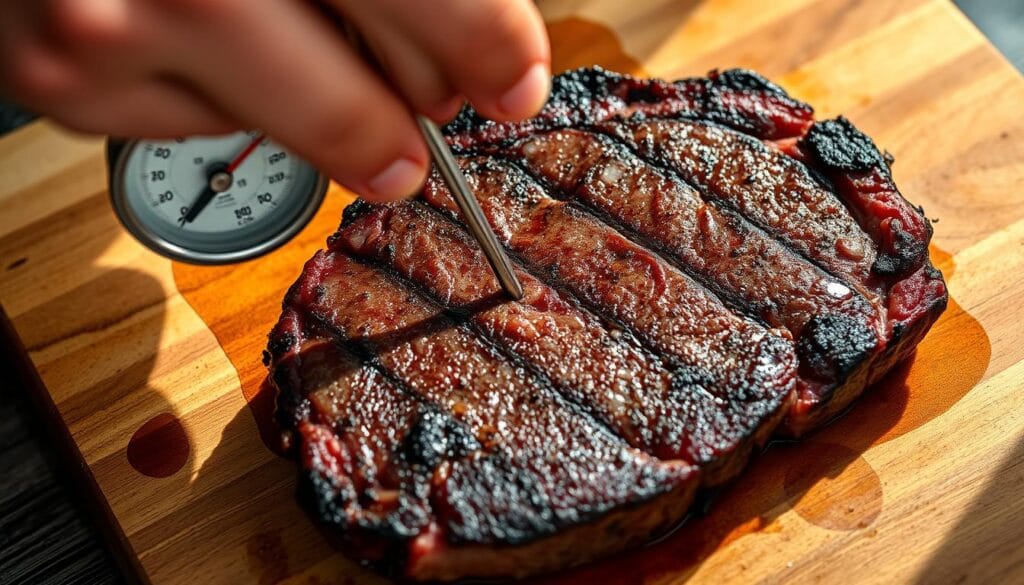
Remember, there’s carryover cooking after you take the steak off the heat. So, take it off a few degrees before your target. Letting it rest makes it tender and juicy.
If you don’t have a thermometer, the finger test works too. Press the steak and compare it to the flesh between your thumb and index finger. This helps guess the doneness.
Enhancing Flavor with Marinades
To make your Delmonico steak even better, try a good marinade. A marinade can add flavor and make the steak tender. The right mix can bring out the steak’s natural taste without being too strong.
Simple Marinade Recipe
A basic marinade for Delmonico steak includes oil, acid, herbs, and spices. Mix olive oil, balsamic vinegar, minced garlic, and fresh herbs like thyme or rosemary. This mix gives a balanced taste that goes well with the steak. You can also look at marinades for venison loin for more ideas.
Recommended Marinade Time
The time you marinate your Delmonico steak matters a lot. A good time is 2 to 24 hours. But remember, too long can make the meat tough. For Delmonico, a few hours is enough to add flavor without losing texture.
Sides That Pair Well with Delmonico Steak
Choosing the right sides is key to a great meal with Delmonico steak. The right sides can make your meal better, mixing flavors and textures.
Classic Steakhouse Sides
Steakhouse sides are a classic choice for Delmonico steak. Here are some favorites:
- Creamed Spinach: A rich, creamy side that goes well with steak.
- Baked Potatoes: A comfort food that’s easy to make and loved by all.
- Sautéed Mushrooms: Mushrooms cooked in butter and garlic add a tasty touch.
- Creamed Corn: Sweet corn in a creamy sauce is a nice contrast to steak.
Healthier Options
Looking for lighter options? Here are some healthy choices:
- Roasted Vegetables: Roasting brings out veggies’ natural sweetness, matching the steak’s flavor.
- Fresh Salads: A simple green salad or a grain salad adds a refreshing twist.
- Whole Grain Sides: Quinoa or brown rice adds fiber and nutrients to your meal.
| Side Dish | Description | Preparation Time |
|---|---|---|
| Creamed Spinach | Rich and creamy spinach | 15 minutes |
| Baked Potatoes | Classic baked potatoes | 45 minutes |
| Sautéed Mushrooms | Earthy mushrooms in butter and garlic | 10 minutes |
| Creamed Corn | Sweet corn in creamy sauce | 20 minutes |
Choosing the right sides makes a delicious and well-rounded meal with Delmonico steak. Whether you pick classic steakhouse sides or healthier options, the goal is to mix flavors and textures well.
Presentation Tips for Your Steak
The art of presenting Delmonico steak is all about the details. A well-presented dish can make your meal more enjoyable. Focus on plating techniques and the garnishes you choose.
Plating Techniques
When plating your Delmonico steak, slice it against the grain for tenderness. Aim for uniform slices for a nice look. This makes your dish visually appealing.
Arrange the steak on a warm plate to keep it hot. You can add height with vegetables or sides around the steak. This makes the dish inviting and balanced.
Garnishes to Consider
Garnishes can add flavor and beauty to your Delmonico steak. Use compound butters or fresh herbs like parsley or thyme. They add color and freshness.
A finishing salt or a drizzle of sauce can also improve the dish. Celebrity chef Gordon Ramsay said,
“The key to a great presentation is to make it look like you’ve put some effort in, but not too much.”
Resting the steak before slicing and using the juices can enhance the presentation. It makes a big difference.
Wine Pairings for Delmonico Steak
Enjoying a perfectly cooked Delmonico steak is even better with the right wine. The steak’s rich flavors and tender texture need a wine that matches its complexity.
Here are some red wines that pair well with Delmonico steak.
Best Red Wine Choices
Some red wines are perfect for Delmonico steak. These include:
- Cabernet Sauvignon, known for its tannins that cut through the richness of the steak.
- Malbec, offering dark fruit flavors that complement the steak’s savory taste.
- Syrah/Shiraz, with its robust flavor profile that matches the steak’s boldness.
| Wine | Characteristics | Price Range |
|---|---|---|
| Cabernet Sauvignon | Tannic, full-bodied | $20-$100+ |
| Malbec | Fruity, smooth | $15-$50 |
| Syrah/Shiraz | Robust, spicy | $18-$60 |
Alternative Pairing Suggestions
Looking for something other than red wine? Craft beers, bourbon, or whiskey can be great. For non-alcoholic options, try a rich, bold tea or a specialty soda that can match the steak’s flavors.
Choosing the right drink to go with your Delmonico steak can make your meal better. Whether it’s a red wine or something else, find a drink that complements the steak’s rich flavors.
Storing Leftover Delmonico Steak
When you have leftover Delmonico steak, it’s key to store it right. This keeps it fresh and safe to eat. Proper storage stops foodborne illnesses.
Cooling and Storage
First, let the steak cool to room temperature in two hours. This step stops bacteria from growing. Then, put it in an airtight container or wrap it tightly.
Refrigeration Tips:
- Use shallow airtight containers for faster cooling.
- Label the container with the date you stored it.
- Keep the fridge at 40°F (4°C) or below.
The steak stays safe in the fridge for 3 to 4 days. If you won’t eat it in that time, freeze it.
| Storage Method | Temperature | Storage Duration |
|---|---|---|
| Refrigeration | 40°F (4°C) or below | 3 to 4 days |
| Freezing | 0°F (-18°C) or below | 2 to 3 months |
Reheating Leftover Steak
Reheating your Delmonico steak is as important as cooking it. You can use the oven, stovetop, or sous vide machine.
Oven Reheating: Preheat to 250°F (120°C). Place the steak on a baking sheet and heat until it’s hot, usually 10-15 minutes.
Stovetop Reheating: Heat a skillet over medium-low. Add oil or butter, then the steak. Reheat slowly, turning it, until it’s hot.
Turning leftover Delmonico steak into new dishes is smart. Slice it for sandwiches, dice it for salads, or chop it for steak hash. Just reheat it gently to keep it tender.
Frequently Asked Questions (FAQs)
Are you ready to cook your Delmonico steak? You might have some questions about how to make it perfect. We’ll answer some common ones about cooking this premium beef cut.
Common Cooking Mistakes
Cooking a Delmonico steak is easy if you know the common mistakes. One big mistake is cooking it straight from the fridge. Always let your steak sit at room temperature for about 30 minutes before cooking to cook evenly.
Another mistake is putting too many steaks in the pan. This lowers the pan’s temperature and steams the steaks instead of searing them. Cook steaks one at a time if necessary, to keep the heat high for a perfect crust.
Not letting the meat rest after cooking is another error. Resting your steak for 5-10 minutes helps the juices spread, making it tender and flavorful.
How to Store Cooked Steak
Storing cooked Delmonico steak right is key to keeping its quality. If you have leftovers, cool the steak to room temperature within two hours to stop bacteria growth.
Once cooled, store it in an airtight container in the fridge for up to three days. For longer storage, freeze it. Wrap the steak tightly in plastic wrap or aluminum foil and then in a freezer-safe bag. Frozen steak can last up to three months.
When reheating, use a gentle method to avoid drying out the steak. You can reheat it in a low oven or on the stovetop with a bit of oil.
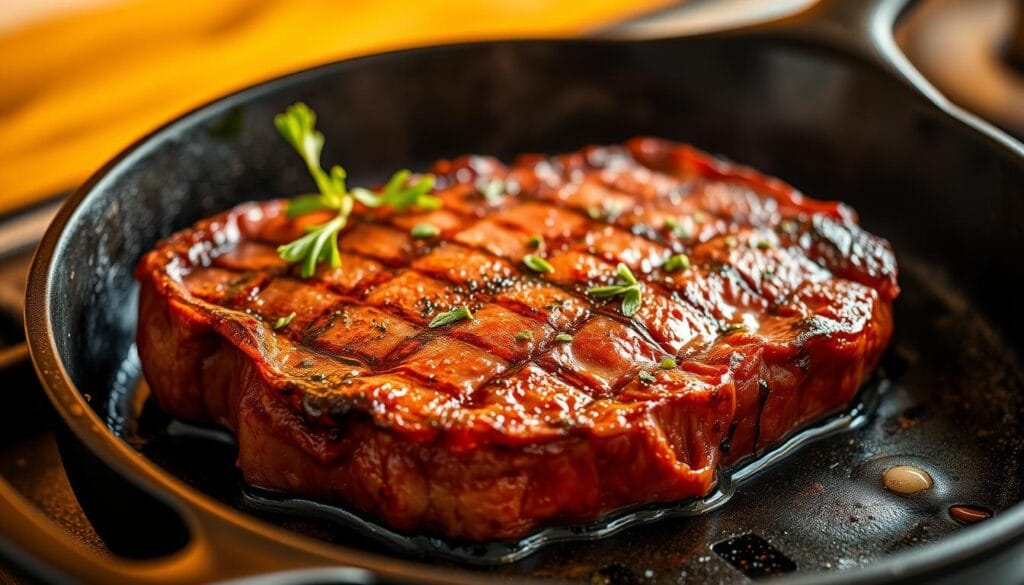
Other questions include the best price for Delmonico steak, substitutes if it’s not available, and how to adjust recipes for different diets or steak sizes. Prices vary by location and quality, but it’s a premium cut. If you can’t find Delmonico, try Ribeye or Strip loin for a similar taste.
For different diets, use gluten-free seasonings or pair with sides that fit your needs. Adjust cooking times for different steak sizes, watching the internal temperature for the right doneness.
“The key to a great Delmonico steak is not just in the cooking, but in the preparation and the quality of the steak itself.”
Conclusion
Now you know how to make a Delmonico steak, from picking the right meat to cooking it just right. This guide shows how important quality ingredients and cooking skills are. You can now bring the steakhouse feel to your home with the delmonico steak recipe.
Key Takeaways
Remember, the key steps are choosing the right cut of meat and understanding different cooking methods. You’ll learn about grilling, pan-searing, and oven finishing. The recipe for delmonico steak also talks about how marinades can boost flavor.
Experimenting with Your Recipe
Start experimenting with different seasonings, marinades, and sides to find your favorite. Whether you’re a pro chef or a home cook, mastering Delmonico steak is all about the basics. Then, you can make it your own. With this guide, you’re ready to create unforgettable meals.
FAQ
What is a Delmonico steak, and what cuts of beef are typically used?
How do I select the right Delmonico steak for my recipe?
What are some common mistakes to avoid when cooking a Delmonico steak?
How do I achieve the perfect doneness when cooking a Delmonico steak?
Can I marinate my Delmonico steak, and if so, for how long?
How should I store leftover Delmonico steak, and how can I reheat it?
What are some recommended wine pairings for Delmonico steak?
How can I cook a Delmonico steak to the perfect level of doneness without a thermometer?
What are some tips for cooking delmonico steak?
What is the best way to cook delmonico steak?
For more cooking tips, stay connected with us. We also recommend the cookbook Skinnytaste Simple: Easy, Healthy Recipes with 7 Ingredients or Fewer
For more Recipes about Steak ?
Did You try our recipe ?
There are no reviews yet. Be the first one to write one.
